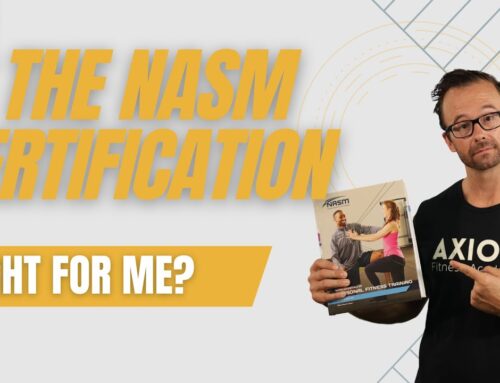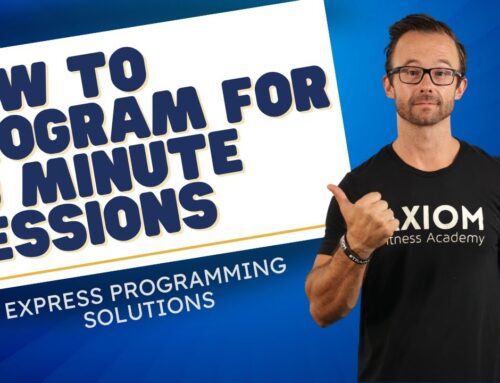If you’re working with clients over the age 25, odds are everyone has pain somewhere in their body. Whether it’s a previous injury from their youth or common aches and pains, you will most likely be working with something.
For most, having a desire to workout while experiencing pain is extremely frustrating. It feels like you can’t do something good for your body without paying a high price of pain for it. This is a common reason someone looks to hire a Personal Trainer in the first place. They need someone with the expertise to guide them through exercises that won’t hurt them.
As a personal trainer, it is important to stay within your scope of practice. That means you cannot diagnose, treat or prescribe anything to a client. That still leaves a lot that you can do, though. Which is design a workout program that helps your clients look, feel and move better.
You can absolutely teach your clients mobility and stabilization exercises that will improve their range of motion, reduce joint pain and potentially remove their pain altogether. You just have to do it in the right way…
Here are 5 Tips to help you do just that:
Assess for what they can do.
An assessment is an important part of getting to know your clients and their bodies, but it’s easy to get caught up in areas they lack, where their weaknesses are, or what they need to fix. As a personal trainer, take the route of emphasizing what they can do, pain free, and focus on that.
That’s not saying to ignore their injuries, just choose exercises that work better.
For example, if you have a client with low back pain, their low back may hurt when deadlifting from the ground but they feel fine doing RDLs. So, choose those as your major hinge movement or another pain-free option.
Start each workout with mobility.
If you remember our “Ultimate Training Session Breakdown” video (if not, click here) you may recall “Prep” as being the first phase to any workout. This should be the first 4-6 minutes of each training session where you focus on improving range of motion for the upcoming workout.
There should be a mix of active stretching, stabilization and muscle activation to prep the body for a workout. This will increase circulation, lubricate the joints and help get your clients into better positions.
For example, if you have a client who experiences shoulder pain doing an upper body workout, spend some time on a lacrosse ball mobilizing the traps and adding in some shoulder CARs. Watch this video for 6 shoulder prep drills.
Use a pain free range of motion.
This seems like a no brainer, but it needs to be said. In some situations, it may be best to just take certain movements out of your clients’ exercise library if it causes them pain.
For other exercises, especially ones that relate to every-day movements (like squatting and deadlifting) it is possible to do the same movement with a smaller range of motion. A squat doesn’t have to hit parallel and a deadlift doesn’t have to start from the ground – range of motion can be different for every single body.
Utilize the range of motion someone has, and start to make improvements from there.
For example, if you have a client who has knee pain while getting up and down from a chair, use a high box to start their squatting from. They may have no pain going just 20-30% into a squat, so strengthen that range of motion and you’ll probably be able to improve it down the road.
Always have a back-up plan.
As important as it is to have a workout planned for your clients’ ahead of time, it is equally as important to be flexible with your plan and adjust to what they need that day. Just because it’s written down doesn’t mean you have to stick with it.
Not only will your clients feel different on different days, they could have completely different ranges of motion as well. It’s not uncommon for someone to walk in with a kink in their neck after sleeping in a weird position. You probably won’t be pressing overhead on that day.
Someone could walk in with extremely tight hip flexors after spending the previous day driving home from a trip. Their squats probably won’t look the same as last session.
Your client could walk in with pain in their low back after moving furniture over the weekend. You should probably change that kettlebell swing to something else.
For every exercise, you should have 1-2 progressions and regressions. This allows you to quickly adjust in the moment if an exercise is too easy or too challenging for somebody. Some exercises may be super easy to switch.People who feel knee pain with forward lunges may be completely fine with reverse lunges.
Other exercises, not so much.
For example, you may have a client who somewhat consistently gets tension headaches. On certain days a plank is no problem, on some days it can be too painful on the neck. Changing this exercise to a deadbug may be a better option – it will still work the core, but place no stress on the neck. (Don’t know what a deadbug is? Watch this quick video.)
And finally…
Ask your clients for in-the-moment feedback.
Obviously communicating with your client is important; we will never know exactly what someone is feeling with an exercise. Even with perfect form, someone could be experiencing pain and it’s not something we will ever see, no matter how experienced you get.
Especially with novice exercisers, they may not fully understand pain from muscle working or “burning.”
It’s up to you to ask the questions and get a sense of what they’re feeling so you can adjust in the moment.
It’s not a good feeling to check in on your clients the next day and have them respond with, “my shoulder hurts from doing push ups in our workout yesterday.” (Or something along those lines.)
As common as having clients with pain is, it takes time and experience to learn how to:
- Assess and understand different bodies so you can program workouts effectively
- Warm them up properly so they move better during their workout
- Quickly adjust exercises so they feel ok
These are all bases we cover in our in-person Certified Personal Trainer course.
Understanding your clients, what they want and how to effectively coach them to achieve their goals is vital. You’re not going to learn all that from a textbook!
Interested? Our next course is starting up soon.







